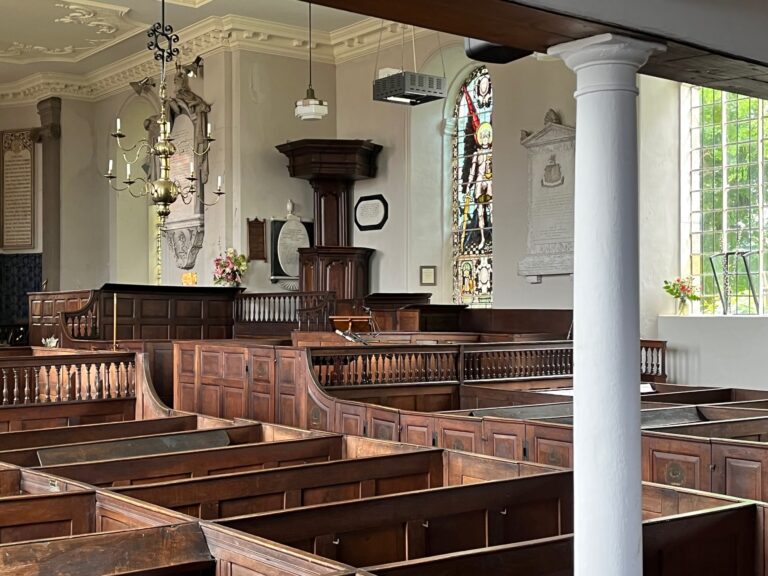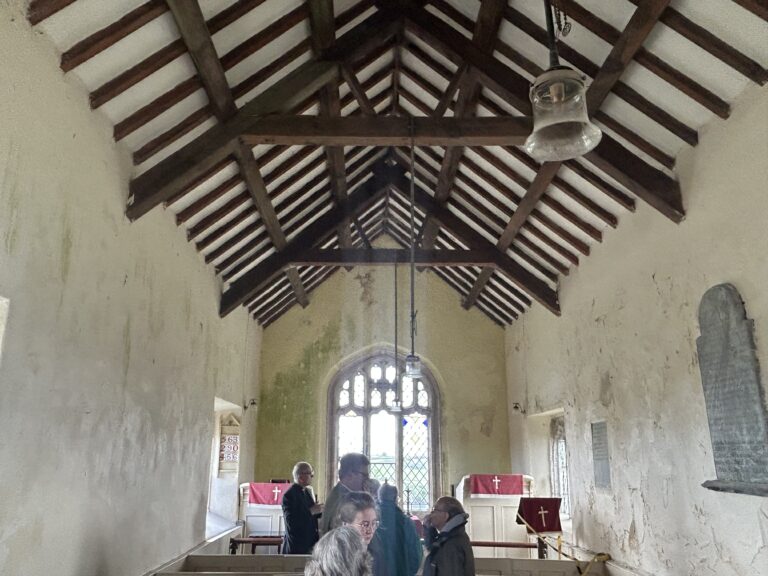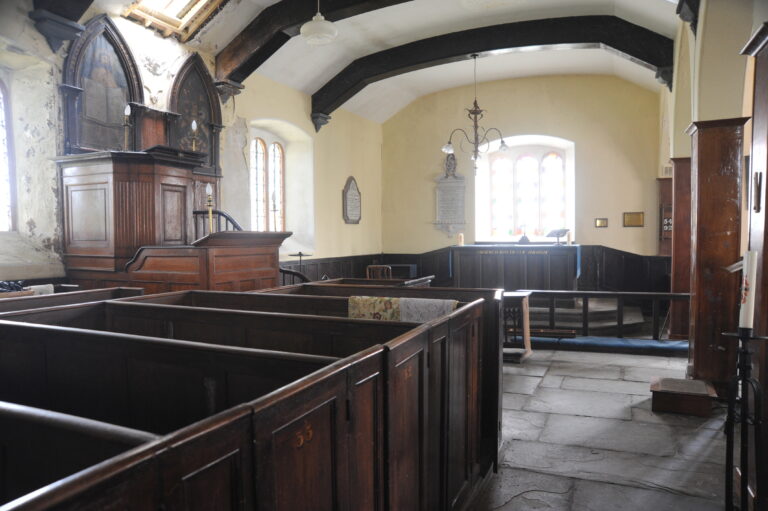
Published: 16/05/2024
Updated: 16/10/2024
A generous benefactor has offered to match-fund any donations we receive this year. Can you make a donation and help us to save four wonderful churches that are in dire need?
We have an amazing opportunity this year — thanks to a supporter, all donations will be match-funded until March 2025, up to a total of £500,000!
Read on to find out about four fantastic churches we hope to save through this fundraising campaign.
First up, is elegant St Deiniol’s, Worthenbury, Wrexham

St Deiniol’s was built by Richard Trubshaw in the 1730s and is one of the greatest Georgian churches in Wales. The red brickwork is accentuated with dressed Cefn-Mawr sandstone to the quoins and window heads. The church has a semi-circular apse at the east end and a three-storey tower with a balustraded parapet and pinnacles at the west end.

The sumptuous interior includes decorative plaster ceilings with deep cornices and Rococo flourishes. Banks of 18th-century box pews with painted crests and brass plaques of local families fill the nave, topped off with a triple-decker pulpit. The timber gallery to the west balances on cast iron columns.
The east window is a kaleidoscope of colourful fragments. In fact, it largely comprises elements from the 1393 Jesse window at Winchester College Chapel. This window was made for the chapel at Winchester by the aptly named Thomas Glazier. It was removed from its original location in the 19th century and fragments sold off.
St Deiniol’s closed last year and is in the process of being transferred to our care. Our repairs will focus on high-level masonry and making safe the electrical installation.
Next, the charming St Twrog’s, Bodwrog, Anglesey

St Twrog’s rises up on a knoll and commands an empty landscape. There are panoramic views in all directions. This small, simple church has the most striking setting. The church was built in Henry VII’s reign (1485–1509), and when Richard Bulkeley was Archdeacon of Anglesey.
St Twrog’s is a simple, rural medieval church. It’s built of rubble masonry with limestone dressings. The nave and chancel are undivided. The principal doorway is to the south. The decorated spandrels carry the arms of Llywarch ap Bran, and possibly a rose. Above the doorway is a stone carved with a bull’s head.
The church retains some medieval windows with delightful tracery to the chancel, while others date from the 17th and 18th centuries. The fittings are all 19th-century – dado panelling and simple pews. The communion rail is upcycled from an older piece of furniture.
The church building is not in the best condition. Damp from defective drains and the very high external ground level on the south side has rotted out much of the timberwork. We need to reduce the moisture levels in the building, by improving drainage, lowering the ground level if archaeology permits, and increasing ventilation to the interior.

The third church we want to help is mysterious St Andrew’s, South Runcton, Norfolk

St Andrew’s has been languishing on a roadside for over a decade. It finally came into our care in 2023.

In 1812 a sketch showed all that was left of the church: a ruinous Norman chancel, with billet and chevron carvings buried under vegetation, and the apse roofless, open to the elements. Norwich architect John Brown rebuilt St Andrew’s in a Neo-Norman style in 1839, but the jury is out on how much of the Norman ruin he incorporated into his richly detailed and dignified redesign.
The west front has giant corner pilasters, bold chevron zigzagging around the arches, a super-arch, and blind arcading. The surface decoration in the blind arches is copied from Norwich Cathedral, where Brown was the Surveyor. The south elevation has more arcading, billet-moulding and a corbel table of stylised heads. The northside is remarkable for its relative plainness. No arcading here. Just a stray carved head or two.
Due to years of neglect, the repairs needed are extensive and expensive (more or less the cost of the other three churches combined). There really isn’t any element of this church that doesn’t need work.
Read more about St Andrew's, South Runcton
Last but but certainly not least: remarkable St Doged’s, Llanddoged, Denbighshire

The moment our Trustees walked through the door of St Doged’s in July 2023 they were determined to save it. Perched high, right in the middle its village, the church closed in 2017, and for a couple of years was trialled as a ‘Pilgrim Church’ by the Church in Wales. For various reasons, this enterprise didn’t work, and now the church needs a new future. Closed and locked-up, the roof over the triple-decker pulpit partially collapsed last year. So, as you can imagine, this is where our repairs will start.
St Doged’s is a late medieval double-naved church within a raised, circular churchyard. Rev. Thomas Davies substantially remodelled it in 1838–9 with the help of his friend, Rev. David Owen, of neighbouring Eglwysbach. From the earlier church, most 16th-century windows survive, along with the medieval octagonal font.
The interior here is extraordinary. Banks of varnished box pews fill the entire space. Tiered box seating to the west end is painted ‘Boys’ and ‘Girls’. The ceilings are shallow and lined with plaster. The boxed beams are carried on wooden Jacobethan corbels. The altar is 20th-century, but the reredos contains re-used sections of late 16th-century secular carved panelling. There is a double-decker pulpit with full painted canvases depicting Christ and the Victoria Regina coat of arms. Overall, this is a fine North-Walian example of a pre-Oxford Movement church.

All of these churches have closed for regular worship, but they are still rich with historical and architectural interest and much-loved by their local communities. With your support, we can start a new chapter for these churches, and keep them open for generations to come.
Learn more about our 2024-25 match-funding campaign or donate now.